This post may contain affiliate links. Please read our disclosure policy.
The secret to the most tender, hearty, and healthy gluten free potato bread is plenty of potatoes, cooked just the right way, blended right into the batter.
Potatoes hold onto moisture without making the bread fragile. So they make an ordinary gf sandwich bread into something really special, with a bakery-style crust and a properly squishy crumb.
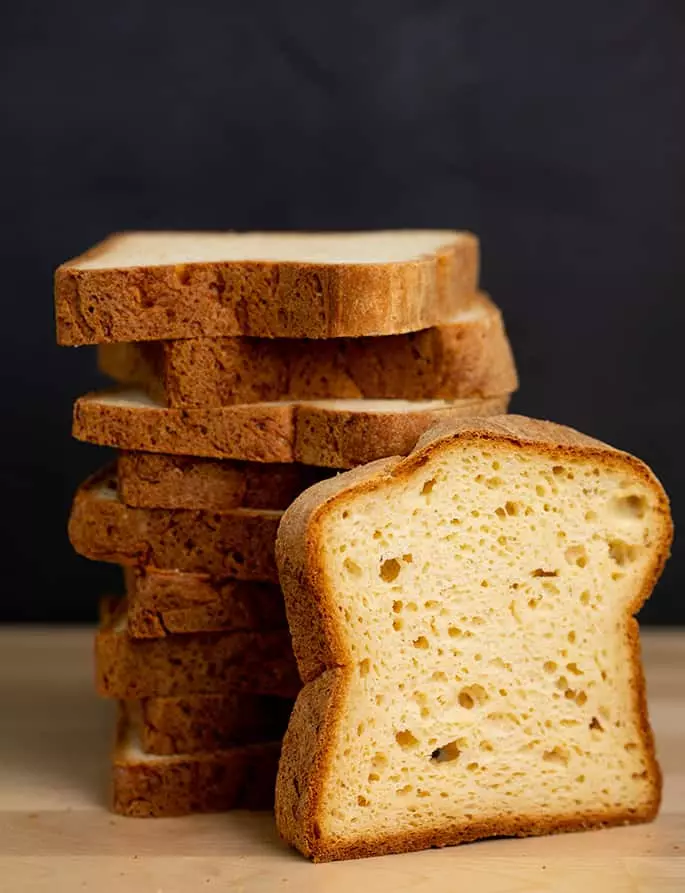
Table of Contents
- Is potato bread made from potatoes?
- What makes potato bread different?
- How to steam potatoes for making this bread
- Why this is the best gluten free potato bread recipe
- Delicious potato bread key ingredients
- Tips for making gluten free potato bread
- Can you use this dough to make gluten free potato rolls?
- What to do with gluten free potato bread
- Storing gluten free potato bread
- Gluten free potato bread: substitutions
- FAQs
- How to make potato bread (gluten free and delicious!)
- Super Soft Gluten Free Potato Bread Recipe
Is potato bread made from potatoes?
Yes! Well, potato bread is made with potatoes, but not solely from potatoes. We blend the liquid in the recipe (here, milk) with eggs and potatoes, and make a smooth mixture that is added to the dry ingredients.
You can steam some whole potatoes just for this recipe (we'll talk about my favorite ways), or you can use leftover potatoes from another meal. You'll only need about 1 large potato, steamed and skinned, then blended.
What makes potato bread different?
Potato bread may look much like our standard gf white sandwich bread, and it's just as easy to make, but it's definitely not the same. Potato bread has a more moist, open crumb than simple white bread, even though it's just as easily sliced and makes a perfect sandwich without ever falling apart.
Are potatoes gluten free?
Yes! From Russet to red-skin to Idaho and more, all plain potatoes are gluten free. They also have tons of benefits, like lots of B vitamins, resistant starch (feeds gut bacteria), and a good amount of fiber. (Source.)
Is potato bread gluten free?
No! “Regular” potato bread is made with all purpose wheat-based flour, so it's not gluten free. But this recipe is made with an all purpose gluten free flour blend, with added tapioca starch/flour for stretch, so it's safely gluten free.
How to steam potatoes for making this bread
You can steam your potatoes in an instant pot, if you have one, or in a regular pot on the stove. In both methods, you need a simple, heat-safe steamer basket (or something that can function as one).
Begin by washing and piercing your potatoes. If you're making them in an instant pot, I like making large russet or Yukon gold potatoes. In a regular pot on the stovetop, mini potatoes work best.
To steam potatoes in a pressure cooker, like the instant pot
Plug in your instant pot electronic pressure cooker, add about 1/4 cup of lukewarm tap water and a heat-safe steamer basket on top. Arrange the pierced potatoes in the steamer basket, without crowding them.
Secure the lid of your instant pot, set the vent to seal, press “manual,” and set the time to 14 minutes. Once cooking has ended, turn the pot off and allow the pressure to release naturally by allowing the pot to sit, undisturbed, for about 15 minutes.
Release any remaining pressure manually by turning the venting dial to “vent.” Using tongs, remove the potatoes from the steamer basket and allow them cool completely before peeling them and using them in this recipe.
To steam potatoes in a regular pot
Add 1-inch of water to a heavy-bottom saute pan, and place a steamer basket on top. Add the potatoes to the steamer basket (small potatoes will work best here, if possible), cover, and bring the water to a boil over medium high heat.
Cook, undisturbed, for about 20 minutes. Turn the heat off and let the pan sit, undisturbed and still covered, for another 10 minutes.
They're done when a sharp knife glides right into the center of the biggest potato. Using tongs, remove the potatoes from the steamer basket and allow them cool completely before peeling them and using them in this recipe.

Why this is the best gluten free potato bread recipe
There are so many features of this bread that make it the best gf potato bread recipe—and one of the best gluten free bread recipes on the whole blog. Here are a few of my favorite things about this bread:
- It has great texture and springiness with the perfect combination of better batter gluten free and added tapioca starch/flour;
- Adding potatoes to the mix, and blending them smooth, means that we can use simple ingredients (no more complex gluten free bread flour elements needed here)
- The dough is one of the easiest to make, since most of the wet ingredients are pureed in a blender, and then poured right into the dry ingredients
- Like all of our batter-style gluten free breads, there's no kneading and no double rise; that means you get to eat thick slices of sandwich bread faster, but the bread still has the best texture and depth of flavor
Delicious potato bread key ingredients
- Potatoes – Potatoes hold moisture better than flour does, but we need to control how much moisture they add, or our bread dough won't bake all the way through. We steam them until tender so they're not wet (like from boiling) and not dry (like from baking).
- Butter – Enrichments like butter and eggs in yeast bread help create mouth feel, and tenderness, plus butter adds a richer taste
- Eggs – The 2 eggs in this recipe help provide structure and lift, plus some richness.
- Instant yeast – I always prefer to bake with instant yeast (also called breadmaker or rapid rise yeast), since it has a smaller coating that dissolves easily without being soaked in liquid first
- Milk – Measure your milk carefully, since too much moisture will make gummy bread; ask me how I know that. :)
- Gluten free flour blend + more tapioca starch – My favorite blend to use to bake bread is Better Batter classic blend (or our mock Better Batter), with added tapioca starch for the proper bend and stretch
- Sugar – A couple tablespoons of granulated sugar help feed the yeast, and also flavor the bread a bit

Tips for making gluten free potato bread
Preparing/choosing your potatoes for gf potato bread
Almost any standard potato will work here, as long as it's prepared properly. I've made this bread successfully with Russet, red-skinned, and yellow/Yukon gold potatoes.
The reason we even make potato bread at all is because potatoes hold moisture better than flour does. We must control how much moisture they add to our bread dough, though, or our bread dough won't bake all the way through—no matter how long it bakes.
The best way to cook our potatoes is to steam them until fork tender. That way, they're not wet (like from boiling) and not dry (like from baking).
Grease your loaf pan well to prevent sticking
If you're using a nonstick loaf pan that's relatively new, its nonstick coating should be intact enough that you only need to grease it very lightly. If your loaf pan is a bit older, or it's not nonstick, make sure you get in every crease and on every inside surface of the loaf with cooking oil spray so that the loaf doesn't stick.
Give your potato bread batter dough time to rise
This potato bread dough is a wet, batter-style gluten free yeast bread loaf, but it's a bit more stiff than our white gf sandwich bread because the addition of cooked potatoes locks away more moisture, so we add less liquid. More wet doughs, like our gluten free artisan bread for example, rise more quickly. This loaf is different.
That means that the dough rises somewhat slowly, so you'll need to be super patient and allow it to rise until it's increased by about 50% in size (it will be 1 1/2 times its original size, reaching close to the top of a standard loaf pan).
Overproofing is a function of rising too much, not too long. And as always, keep in mind that getting yeast bread to rise is extremely environment dependent. Yeast will rise much faster in a warm, moist environment, and more slowly in a cool, dry one.
And make sure your loaf is covered properly with plastic wrap or the lid of a Pullman pan during its rise, or it will dry out as it sits, and may lose enough moisture that it never rises properly.
Let your potato bread cool before slicing
All yeast breads, especially in loaves that you slice to make sandwiches, should cool completely before you slice them. Otherwise, the loaf tends to collapse on the top and sides. That goes double for this gf potato bread!
This loaf is designed to be even more moist and tender, but that means that it will have some more moisture, even when it's completely baked all the way through.
The sides of the loaf will cave in a bit as the loaf cools, but they won't compress. To minimize this effect, you can rotate the loaf on the wire rack, allowing it to cool on each side for about 10 minutes, and even upside down, before righting it to allow it to cool completely.

Can you use this dough to make gluten free potato rolls?
I don't recommend using this dough to make gluten free potato rolls, no. Rolls are tricky to make with a batter-style gluten free bread dough like this. Instead, I'd use our recipe for gluten free pretzel rolls or gf hamburger buns for soft, tender gf sandwich rolls.
What to do with gluten free potato bread
This hearty, tender yeast bread with a beautiful thick crust can be used so many ways. Here are a few suggestions:
- Slice the bread thickly, and make amazing gluten free French toast with it.
- Slice it thinly, toast the slices, and serve with butter, jelly, or peanut butter, drizzled with honey
- Slice it medium-thick, and make amazing lunch sandwiches or perfect gluten free grilled cheese
Storing gluten free potato bread
Since this yeast bread is quite moist, it will stay fresh for about 2 days at room temperature on the kitchen counter if wrapped tightly. That's a long time for fresh bread, really. Just think of the term “day old bread”!
Freezing gf potato bread for later
For longer storage, I never like to refrigerate yeast bread, since the refrigerator tends to be drying. Instead, after slicing the bread, try wrapping a few slices tightly in a freezer-safe wrap like Glad Press ‘n' Seal and storing them in the freezer.
Defrost a few slices at a time at room temperature, then sprinkle lightly with water and refresh in a 275°F toaster oven. You can also just put the frozen slices in the toaster and toast them slowly, on a low temperature, until defrosted and crispy on the edges.
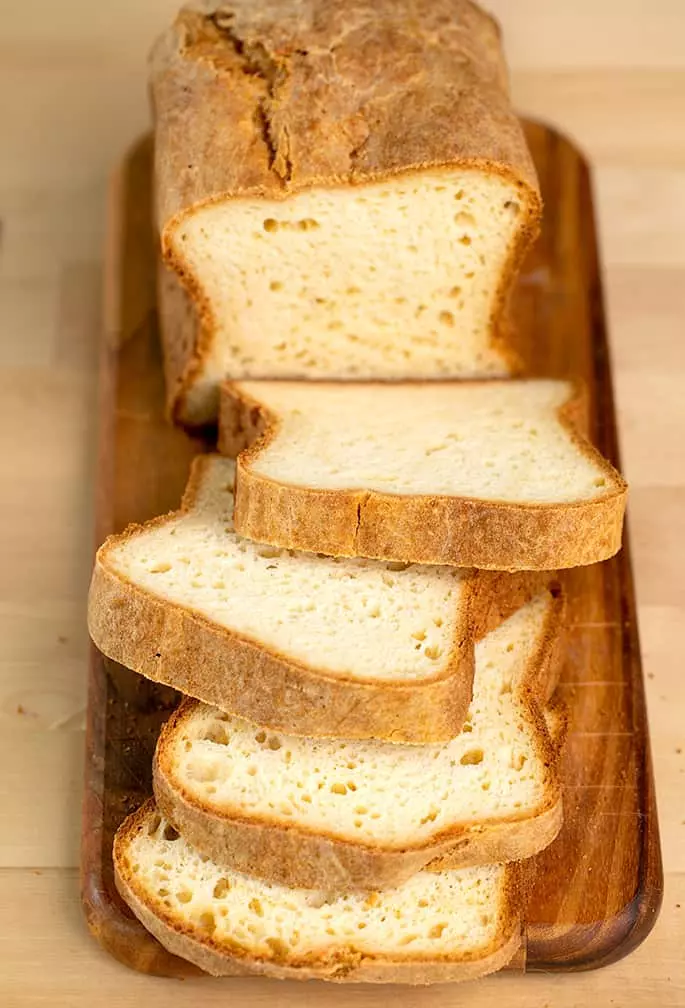
Gluten free potato bread: substitutions
Dairy free, gluten free potato bread
To replace the dairy in this yeast bread is pretty easy. In place of the cow's milk, use your favorite unsweetened nondairy milk. I like almond milk best, since it's not fat free. In place of butter, use Melt or Miyoko's Kitchen brand vegan butter.
Egg free, gluten free potato bread
To make gluten free potato bread also egg-free, try replacing the two eggs with one “chia egg” each. For each chia egg, mix 1 tablespoon ground white chia seeds with 1 tablespoon lukewarm water and allow it to sit until it gels.
Vegan, gluten free potato bread
To make vegan gluten free potato bread, use the dairy substitutes and egg substitutes described above. Be sure you're using granulated sugar that isn't made with bone char, or it won't be vegan.
Using active dry yeast instead of instant yeast
If you only have active dry yeast, you'll need to use 25% more of it and dissolve it in some milk from the recipe to “prove” it before using it in the bread dough. In this recipe, that means you'd need 125% of 6 grams of instant yeast, or 7.5 grams. Do your best to approximate that specific amount, since your scale likely won't measure half grams.
Tapioca starch/flour
This gf bread is made with a combination of one of my favorite all purpose gluten free flour blends (Better Batter classic blend) and additional tapioca starch/flour. The additional tapioca starch helps make the bread stretchy and stable.
There is no real replacement for tapioca starch, either as a separate ingredient or as an element of Better Batter or Cup4Cup, my other favorite gf blend. If you can't have tapioca starch, I'm afraid this bread recipe isn't for you.
Using sweet potatoes
I haven't tried this recipe using sweet potatoes in place of white potatoes, but if you'd like to try, I have some suggestions for how to prepare them.
I would recommend baking the sweet potatoes until very tender in a 375°F oven first. Sweet potatoes naturally have more moisture, so they need to dry out a bit in the oven first.
Medium-size sweet potatoes will usually bake fully at 375°F after approximately 40 minutes. They're ready when they're soft to the touch. Cool, peel, and measure out 160 grams, then proceed with the recipe as written in place of white potatoes.

FAQs
Is there gluten in potatoes?
If you're wondering if russet potatoes are gluten free, you can rest easy. They're completely gluten free. So are all other types of single-ingredient potatoes.
Does potato bread have gluten?
Yes—unless you're eating potato bread that is made to be gluten free, like in this recipe. Traditionally, potato bread is made using all purpose wheat flour, so it's not gluten free.
Is yeast gluten free?
Yes, baker's yeast, which is the kind used in baking bread, like in this recipe, is safely gluten free. Stay away from brewer's yeast, though, which is the type used to make beer.
Can I use leftover baked potatoes to make gf potato bread?
You can use leftover baked potatoes to make this gf potato bread, but you may need to add a bit more milk or even a few drops of water to the bread. Baked potatoes tend to be dry, compared to steamed or boiled potatoes.
Prepare the bread dough as instructed, but watch the video closely for the texture of the bread. If your bread dough seems too stiff, add more milk or warm water by the drop until the texture seems just right.
Can I use mashed potatoes for this gluten free potato bread recipe?
If your mashed potatoes contain butter and/or milk mixed in, they're not the best choice for using in place of the steamed and peeled potatoes in this recipe. There's no way to know how much of the mashed potatoes are potato, and how much are the other ingredients.
Next time you make mashed potatoes, try saving some of the plain potatoes on the side to make a loaf of potato bread.
Can I use mashed potato flakes in this potato bread recipe?
No, this bread can only be made with whole potatoes, not mashed potato flakes, which have been dehydrated.
What's the best pan for making this potato bread recipe?
A light-colored, nonstick cast aluminum 1-pound loaf pan that's approximately 9-inches x 5-inches x 2.5-inches works really well here. Avoid dark-colored pans which darken the crust too much, or glass loaf pans, which get too hot.
You can also use a 1 pound Pullman pan, which measures 5-inches tall, instead of 2.5-inches tall. I don't recommend baking the loaf with the cover on though, since the loaf tends to collapse when you remove the lid.

How to make potato bread (gluten free and delicious!)
Super Soft Gluten Free Potato Bread Recipe
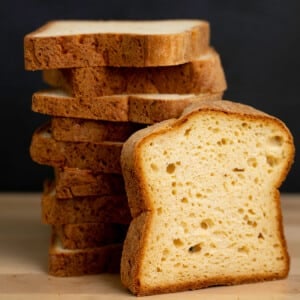
Equipment
- Blender
Ingredients
- 1 cup (160 g) steamed, peeled, and cubed white potatoes, (Russet, red-skin, Yukon gold, or mini) (See Recipe Notes for preparation instructions)
- 1 cup (8 fluid ounces) lukewarm milk
- 2 (100 g (weighed out of shell)) eggs, at room temperature
- 2 cups (280 g) all purpose gluten free flour blend, (I used Better Batter; click through for appropriate gf flour blend info)
- 1 teaspoon xanthan gum, omit if your blend already contains it
- 10 tablespoons (75 g) tapioca starch/flour
- 2 tablespoons (25 g) granulated sugar
- 2 teaspoons (6 g) instant yeast, also called rapid-rise or breadmaker yeast
- ¾ teaspoon kosher salt
- 4 tablespoons (56 g) unsalted butter, melted and cooled
- Cooking oil spray
Instructions
- Grease a standard 1-pound loaf pan and set it aside.
- Place the potatoes, milk, and eggs, in a blender, and blend on high speed just until smooth. Don’t blend very long or you’ll activate the starch too much and your mixture will become glue-like. Set the potato mixture aside.
- In the bowl of a stand mixer fitted with the paddle attachment, place the flour blend, xanthan gum, tapioca starch/flour, sugar, and instant yeast. Whisk to combine well. Add the salt, and whisk again to combine.
- Create a well in the center of the dry ingredients, and add the potato mixture, and the melted butter.
- Beat in a stand mixer fitted with the paddle attachment until well-combined. Continue to beat until the mixture begins to take on a whipped appearance, 3 to 4 minutes. The bread dough will be thick but soft.
- Transfer the dough to the prepared 1 pound loaf pan. Smooth the top into an even layer with a moistened spatula.
- Cover the loaf pan, and set in a warm, draft-free location to rise. Allow the dough to rise until about 150% of its original size.
- Yeast bread dough will rise more slowly in cooler, drier conditions, and faster in warmer, humid conditions. Be patient.
- Remove the cover on the risen dough, and spray the top with cooking oil spray until it glistens.
- Place the pan in the center of the preheated oven. Bake at 350°F for 45 minutes.
- Reduce the oven temperature to 325°F and continue to bake until the internal temperature of the bread is about 210°F on an instant read thermometer, the bread is golden brown all over, and the center feels firm when pressed with the tip of your finger. That should take about another 20 minutes, but may take longer. If the loaf doesn’t feel firm enough but is becoming too brown, lower the oven temperature to 300°F for the remainder of the baking time.
- Remove the loaf in the baking pan from the oven and place it on a wire rack to cool for 10 minutes. Try the loaf out of the pan and onto the wire rack, and allow the bread to cool completely before slicing and serving.
- The loaf may sink a bit on the top and sides, since the bread is so moist and tender. As long as you allow it to cool completely, the bread will remain soft and fluffy inside, never compressed.
Video
Notes
Nutrition information is automatically calculated, so should only be used as an approximation.

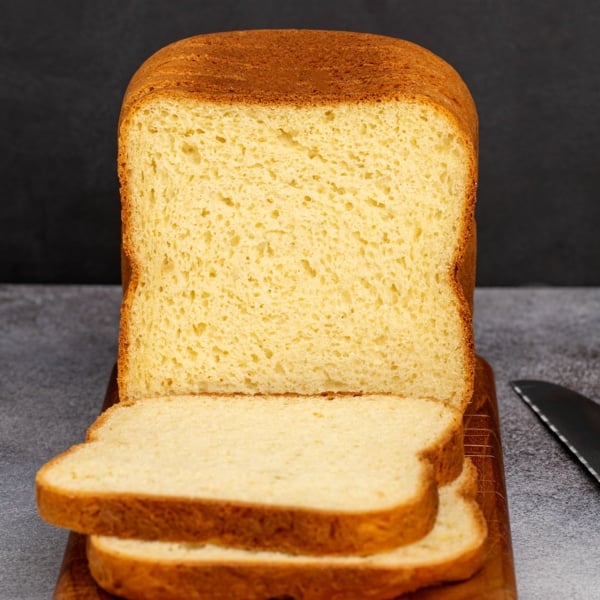

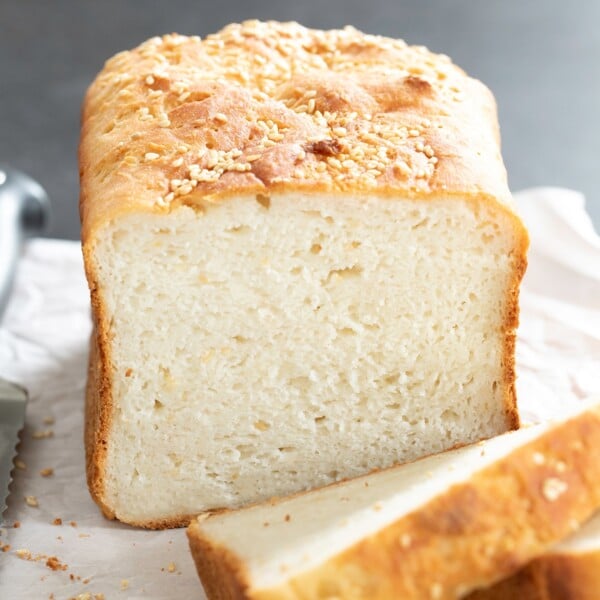










Hi, how long do you let this rise? I let it go about 3 hours and thought it was ready to go but it’s only about 2 inches high after baking.
Annie, rising time is always very environment dependent, so it’s very approximate. When you don’t get the rise you’re hoping for, here’s what you should consider for troubleshooting:
Did you make ingredient substitutions? Unfortunately, they’re not all created equal, and some I actively recommend against. Sadly, some of the most readily available, most affordable blends create poor or at best inconsistent results. Please see the AP GF flour blends page on the blog, which is linked in every recipe that calls for one for full info on what blends I recommend, which to avoid, and how to make your own “mock” version of my favorite blends if you can’t access the readymade ones.
Did you measure by weight, not volume? I wish we could get accurate measurements by volume, but I’d get a different amount every time, even using the same measuring cups. It’s just not possible to avoid human error that way, and cup sizes are just not standardized in the U.S., at least.
With respect to yeast bread, did you allow the dough to rise long enough, and was your dough covered properly? Overproofing is a function of rising too much, not too long. It can take a long time for yeast bread to rise properly in a cool, dry environment, especially.
Again, I really hope these troubleshooting tips are helpful, and that you’re able to use the recipe successfully. I know how much we all miss our old favorites, and I work really hard to try to help bring them all back. I hope this is helpful!